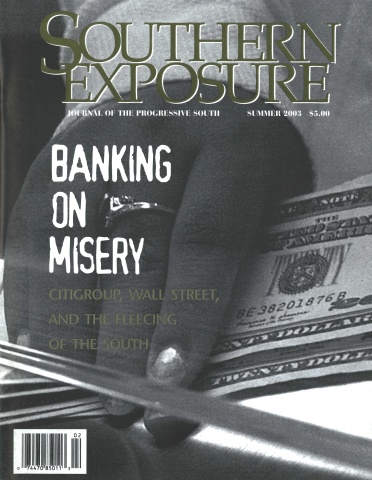Predatory Lending and the Law: Ingredients of Reform

This article first appeared in Southern Exposure Vol. 31 No. 2, "Banking on Misery." Find more from that issue here.
Legal reforms that work must address the specific practices used by lenders to strip borrowers’ equity and avoid the loopholes that have plagued Federal efforts. North Carolina passed the nation’s first anti-predatory lending law in 1999, but other states, such as New Mexico and New Jersey, have recently enacted laws expected to deliver even more protection.
Each of these states has one thing in common—they rely on substantive protections rather than increased disclosure requirements. In the blizzard of paperwork that has become common at loan closings, disclosures become just another “sign here” moment. Successful reforms should accomplish the following objectives:
Apply to full range of home loans. Many industry proposals have excluded certain types of loans (such as increasingly popular home equity lines of credit), loans made by certain groups of lenders (such as mortgage brokers and their partners), and even loans used to purchase homes (as opposed to refinances).
Scrutinize all the fees paid by borrowers. Any law that creates a loophole for fees will surely miss the mark. Most laws have points and fees “triggers” that activate protections, but if the definitions are unclear, a loophole results. Among the fees most likely to be omitted are the two biggest loopholes in federal law—prepayment penalties and indirect mortgage broker compensation, where the lender pays the broker up-front and subsequently charges the borrower a higher interest rate over the life of the loan.
Provide meaningful protection against flipping. Flipping describes situations
where lenders make a loan to generate fee income without providing the borrower with a
tangible net benefit. The abuse often takes place just below designated levels of points and
fees or interest that would trigger additional protections. For example, a lender who did not
want to comply with consumer protections required on a loan with fees above five percent
might simply make two loans at 5 percent in fees—stripping 10 percent in equity.
Target most protections to high-cost home loans. In some instances, practices that are appropriate in the competitive prime market are abusive in higher-cost loans. For example, some sophisticated borrowers elect to use negative amortization (where a loan balance actually increases over time) to limit their payments. However, this same technique is used by abusive lenders to hide the true cost of high-cost home loans. Successful legislation should require applicants for high-cost loans to receive counseling on the advisability of the transaction before putting their homes at risk.
Provide strong incentives for compliance. To prove effective, a successful reform will give lenders a reason to comply with the law. Part of that solution must include provisions for court awards to deter predatory lenders. Without such strong incentives for compliance driven by individual homeowners, reforms prove little more than speed bumps.
Enable borrowers to defend their homes and home equity against illegal loans. Borrowers must have an effective tool for defending their home against illegal loans that have been resold on the open market, as is the case for the clear majority of home loans. Without special provisions addressing this issue, sometimes called “assignee liability,” borrowers whose loans have been sold will be unable to defend against foreclosure even when the foreclosing company has been collecting on an illegal loan for years. The failure of legislation to provide such a mechanism would create a powerful incentive for illegal loans to be sold on the open market and, in effect, laundered—leaving only the borrower and his community to bear the weight of the loan and subsequent risk of foreclosure.
Tags
Keith Ernst
Keith Ernst is an attorney for the Center for Responsible Lending, and a member of the editorial board of Southern Exposure. (2003)